|
|
|
 |
 |

 |
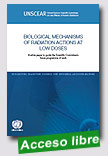 |
Biological Mechanisms of Radiation Actions at Low Doses - A white paper to guide the Scientific Committee’s future programme of work
United Nations Scientific Committee on the Effects of Atomic Radiation (UNSCEAR), 2012, 45 p.
At its fifty-ninth session (21–25 May 2012), the Scientific Committee considered a short review document on the biological mechanisms of radiation actions at low doses. That document, unlike the Committee’s standard full evaluations, was not intended to be comprehensive; it was rather intended to highlight major advances in the field that would provide guidance |
for developing the Committee’s future programme of work. Because the document would be of wider interest, the Committee requested the secretariat to investigate means to issue it as a public document on its website.
The document concludes that understanding of the mechanisms of so-called non-targeted and delayed effects is improving and that there is some evidence for differential responses in gene and protein expression for high- and low-dose radiation exposures, but there is a lack of consistency and coherence among reports. There is as yet no indication of a causal association of those phenomena with radiation-related disease. With regard to immune response and inflammatory reactions, there is a clearer association with disease, but there is no consensus on the impact of radiation exposure, particularly at low doses, on those physiological processes. While the document focuses on mechanisms relevant to carcinogenesis, some of the processes considered may be relevant for tissue reactions, and improved understanding may therefore be helpful for assessing the potential risk of non-cancer diseases at low and protracted exposures.
The Committee agreed to: (a) Continue to encourage research into the mechanistic understanding of low-dose radiation action that may contribute to disease in humans; (b) Consider further developing biologically based risk models and a systems biology framework to integrate mechanistic data into risk assessment; (c) Make the document publicly available; and (d) Review the subject again in three to four years, as appropriate.
Extraído de:
http://www.unscear.org/docs/reports/Biological_mechanisms_WP_12-57831.pd
|
 |
 |
Health risk assessment from the nuclear accident after the 2011 Great East Japan earthquake and tsunami, based on a preliminary dose estimation
World Health Organization (WHO), 2013, 172 p.
The earthquake and tsunami in Japan on 11 March 2011 led to releases of radioactive material into the environment from the Tokyo Electric Power Company’s Fukushima Daiichi nuclear power plant.
A major release of radioactivity to the environment is always of concern, owing to potential acute and long-term health effects. |
Evidence from historic events confirms that any major uncontrolled release of radiation should be cause for immediate response and scientific assessment of potential health effects.
When such an event occurs, the World Health Organization’s mandate, as described in the Joint Radiation Emergency Management Plan of the International Organizations, is to assess and respond to public health risks.
The primary purpose of this health risk assessment of the Fukushima Daiichi nuclear accident is to estimate its potential public health impact so that future health needs can be anticipated and public health actions can be taken. This assessment is based on a preliminary estimate of radiation doses, as described in a WHO report published in May 2012.
Executive summary
Extraído de: http://www.who.int/ionizing_radiation/pub_meet/fukushima_report/en/index.html
|
 |
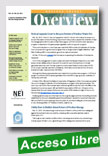 |
Performance‐Based Strategy for Filtering Is Best Choice, NEI Tells NRC
Nuclear Energy Institute (NEI), January 2013, 12 p
A performance‐based approach to filtering is the best choice for minimizing radioactive releases in the event of a severe nuclear accident, NEI said in a letter to the NRC.
A performance‐based approach to filtering “is the right thing to do because it focuses the response to a severe accident on those actons best able to manage the accident and mitigate potential radiation releases,” the Jan. 25 letter said. “It protects |
public safety and the environment by providing greater defense‐in‐depth for the containment function than other optons.”
Extraído de: http://resources.nei.org/documents/NEO.pdf
|
 |
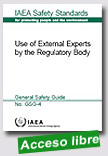 |
This Safety Guide provides recommendations and guidance on meeting the requirements of IAEA Safety Standards Series No. GSR Part 1 on obtaining expert advice or services for the regulatory body. The publication provides recommendations and guidance on the process the regulatory body should use to determine the need for external expert advice, and the processes and procedures it should use for identifying a suitable support provider and making contractual arrangements for the work. It
|
also provides recommendations and guidance on how the regulatory body should take the advice of external experts into account while still retaining responsibility in making its decisions.
Extraído de:
http://www-pub.iaea.org/books/IAEABooks/8934/Use-of-External-Experts-by-the-Regulatory-Body
|
 |
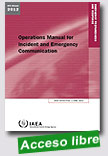 |
Operations Manual for Incident and Emergency Communication
IAEA Emergency Preparedness and Response, 2012, 65 p.
The objective of IEComm Operations (Incident and Emergency Communication) is that its application improves the information exchange on nuclear or radiological incidents and emergencies between the IAEA’s Secretariat, the IAEA’s Member States, Parties to the Early Notification and Assistance Conventions, relevant international organizations and other States. The manual gives guidance to the IAEA Member States, State Parties
|
and relevant international organizations to develop suitable arrangements to interface with each other and the IAEA Secretariat. In addition, IEComm is also designed to contain, in one manual, practical information relating to when and how to invoke these arrangements.
Extraído de:
http://www-pub.iaea.org/MTCD/Publications/PDF/EPR_IEComm-2012_Web.pdf
|
 |
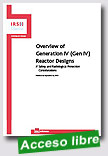 |
Overview of Generation IV (Gen IV) Reactor Designs - Safety and Radiological Protection Considerations
Institut de Radioprotection et de Sûreté Nucléaire (IRSN), September 24, 2012, 106 p.
This document is a follow-on to the one that IRSN published on the same subject in 2007, Reference Document. Its purpose is to provide an updated overview of specific safety and radiological protection issues for all the reactor concepts adopted by the GIF, independent of their advantages or disadvantages in terms of resource optimization or long-lived-waste reduction. In particular, this new document attempts to bring out the advantages and
|
disadvantages of each concept in terms of safety, taking into account the Western European Nuclear Regulators' Association (WENRA) statement concerning "safety objectives for new nuclear power plants" issued in November 2010, Reference Document.
Em francês:
Panorama des Filières de Réacteurs de Gènèration IV - Appréciations en matière de sûreté et de radioprotection
Extraído de:
http://www.irsn.fr/EN/Research/publications-documentation/Scientific-books/Pages/reference-documents.aspx
|
 |
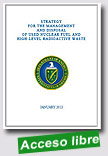
|
Strategy for the Management and Disposal of Used Nuclear Fuel and High-Level Radioactive Waste
US Department of Energy (DOE), January 2013, 8 p.
The Strategy for the Management and Disposal of Used Nuclear Fuel and High-Level Radioactive Waste is a framework for moving toward a sustainable program to deploy an integrated system capable of transporting, storing, and disposing of used nuclear fuel1 and high-level radioactive waste from civilian nuclear power generation, defense, national security and other activities.
The Strategy addresses several important needs. First, it serves
|
as a statement of Administration policy regarding the importance of addressing the disposition of used nuclear fuel and high-level radioactive waste; it lays out the overall design of a system to address that issue; and it outlines the reforms needed to implement such a system. Second, it presents the Administration’s response to the final report and recommendations made by the Blue Ribbon Commission on America’s Nuclear Future (“BRC”). It also responds to direction in the Joint Explanatory Statement accompanying the Consolidated Appropriations Act, 2012, to develop a strategy for the management of used nuclear fuel and nuclear waste in response to the BRC’s recommendations. Third, this strategy represents an initial basis for discussions among the Administration, Congress and other stakeholders on a sustainable path forward for disposal of nuclear waste.
The Administration endorses the key principles that underpin the BRC’s recommendations. The BRC’s report and recommendations provide a starting point for this Strategy, which translates many of the BRC’s principles into an actionable framework within which the Administration and Congress can build a national program for the management and disposal of the nation’s used nuclear fuel and high-level radioactive waste.2 The BRC report and the Strategy build on the body of physical and social science work completed during the prior decades and benefit from the lessons learned not only from our nation’s experiences, but also from those of other countries.
This Strategy includes a phased, adaptive, and consent-based approach to siting and implementing a comprehensive management and disposal system. At its core, this Strategy endorses a waste management system containing a pilot interim storage facility; a larger, full-scale interim storage facility; and a geologic repository in a timeframe that demonstrates the federal commitment to addressing the nuclear waste issue, builds capability to implement a program to meet that commitment, and prioritizes the acceptance of fuel from shut-down reactors. A consent-based siting process could result in more than one storage facility and/or repository, depending on the outcome of discussions with host communities; the Nuclear Waste Policy Act of 1982 (NWPA) envisaged the need for multiple repositories as a matter of equity between regions of the country. As a starting place, this Strategy is focused on just one of each facility.
Extraído de:
http://www.oecd-nea.org/tools/publication?query=&div=
&lang=&period=6m&sort=title&filter=1#p6888
|
 |
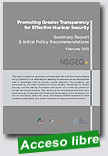 |
Promoting Greater Transparency for Effective Nuclear Security - Summary Report & Initial Policy Recommendations
Nuclear Security Governance Experts Group (NSGEG), Stanley Foundation, February 2013, 18 p.
This report is based on discussions of the Nuclear Security Governance Experts Group (NSGEG) at its Workshop on Building Transparency in Nuclear Security held in September 2012 in London, United Kingdom. The workshop was sponsored by the Asan Institute for Policy Studies, Partnership for Global Security, and the Stanley Foundation and is part of a continuing project on nuclear security governance. This report |
and its recommendations draw upon major strands of discussion put forward at the workshop and in its papers, but do not necessarily reflect the views of individual NSGEG members or other workshop participants who neither reviewed nor approved this document.
Extraído de: http://www.stanleyfoundation.org/nsgeg/NSGEGLondon
Report022013.pdf?utm_source=Paulo%27s+Corner+Daily+Nuclear+
News+Digest&utm_campaign=a31be93194-RSS_EMAIL_CAMPAIGN&utm_medium=email
|
 |
 |
Current Research in Nuclear Reactor Technology in Brazil and Worldwide
InTech, February 06, 2013, 336 p.
The aim of this book is to disseminate state-of-the-art research and advances in the area of nuclear reactors technology. The book was divided in two parts.Topics discussed in the first part of this compilation include: experimental investigation and computational validation of thermal stratification in PWR reactors piping systems, new methods in doppler broadening function calculation for nuclear reactors fuel temperature, isothermal |
phase transformation of uranium-zirconium-niobium alloys for advanced nuclear fuel, reactivity Monte Carlo burnup simulations of enriched gadolinium burnable poison for PWR fuel, utilization of thermal analysis technique for study of uranium-molybdenum fuel alloy, probabilistic safety assessment applied to research reactors, and a review on the state-of-the art and current trends of next generation reactors. The second part includes: thermal hydraulics study for a ultra high temperature reactor with packed sphere fuels, benefits in using lead-208 coolant for fast reactors and accelerator driven systems, nuclear power as a basis for future electricity production in the world: Generation III and IV reactors, nanostructural materials and shaped solids for improvement and energetic effectiveness of nuclear reactors safety and radioactive wastes, multilateral nuclear approach to nuclear fuel cycles, and a cold analysis of the Fukushima accident.
Extraído de: http://www.intechopen.com/books/current-research-in-nuclear-reactor-technology-in-brazil-and-worldwide
|
 |
|
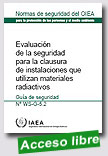
|
Evaluación de la seguridad para la clausura de instalaciones que utilizan materiales radiactivos para la protección de las personas y el medio ambiente
Guía de seguridad del OIEA, 2012, 83 p.
El objetivo de la presente guía de seguridad es formular recomendaciones sobre la preparación y el examen de evaluaciones de la seguridad para las actividades de clausura. También se proporcionan orientaciones relativas al examen de esas evaluaciones. Otro objetivo de esta guía es prestar asistencia a los reguladores, explotadores y especialistas técnicos de apoyo para la aplicación de un enfoque graduado |
en la preparación y el examen de las evaluaciones de la seguridad.
En esta guía de seguridad se proporcionan orientaciones para establecer un marco reglamentario en el que la evaluación de la seguridad se elabore como parte del plan de clausura de una instalación. Ahora bien, es sabido que a nivel internacional se aplican varios enfoques, por ejemplo: las evaluaciones se consignan en un documento separado o forman parte del plan de clausura o bien se utilizan para apoyar dicho plan pero no están sujetas a controles reglamentarios separados. Las orientaciones que se facilitan en esta guía se pueden aplicar cualquiera que sea el enfoque adoptado para las evaluaciones o la forma de abordar el proceso de evaluación en un marco reglamentario nacional.
Extraído de: http://www-pub.iaea.org/MTCD/Publications/PDF/Pub1372s_web.pdf
|
|
|
|
|
|
|
